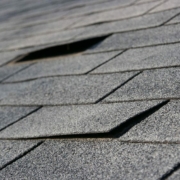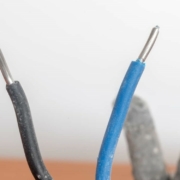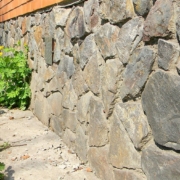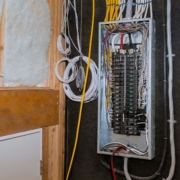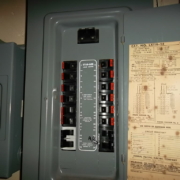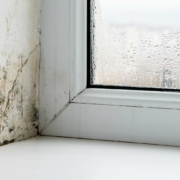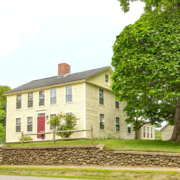As a homeowner, discovering cracks in your walls, floors, or ceilings can be unsettling. However, not all cracks are cause for immediate concern. Understanding the different types of settlement cracks and what they mean can help you determine whether you need to take action or simply monitor the situation.
1. Hairline Cracks In Sheetrock
Appearance: Thin, almost thread-like lines. Common Locations: Walls and ceilings.
Meaning: Hairline cracks are typically a result of the natural settling of a new home. Cracks in walls and ceilings under ¼ inch are generally not a sign of serious structural issues. These cracks are often caused by the expansion and contraction of the wood framing due to humidity changes. While wood can expand and contract, sheetrock does not, and will often have small cracks. Other causes are high stress points such as near beams or other high load-carrying areas, and common settling of the home. While they generally don’t require major repairs, you can fill and repaint them for cosmetic purposes.
2. Vertical Cracks
Appearance: Cracks running up and down, often straight. Common Locations: Foundation walls.
Meaning: Vertical cracks are commonly found in poured concrete foundations. They often appear within the first few years after construction as the house settles. These cracks usually don’t indicate a significant structural problem unless they are wide (more than ¼ inch) or increase in width over time. Sealing them with epoxy or polyurethane can prevent water intrusion.
3. Horizontal Cracks
Appearance: Cracks running horizontally. Common Locations: Basement walls.
Meaning: Horizontal cracks are more concerning than vertical cracks and can indicate serious structural issues. They often suggest that external pressure on the wall (such as from expanding soil or hydrostatic pressure) is causing the foundation to bow or tilt. Immediate professional assessment is recommended as these cracks can lead to significant structural damage if not addressed.
4. Diagonal Cracks
Appearance: Cracks at an angle, typically less than 45 degrees. Common Locations: Foundation walls, around windows and doors.
Meaning: Diagonal cracks are often caused by differential settlement, where one part of the foundation settles more than another. These can also result from seasonal changes in the soil moisture content. If the cracks are under ¼ inch and stable, they might not be urgent. However, a professional evaluation is necessary if they widen over time or are accompanied by other signs like sticking doors or windows.
5. Step Cracks
Appearance: Cracks following the mortar lines in a step-like pattern. Common Locations: Brick or block foundations.
Meaning: Step cracks usually indicate settlement issues in block or brick foundations and walls. They can signal differential settlement or foundation movement. While small, stable step cracks can be sealed and monitored, larger or widening cracks may require underpinning or foundation stabilization.
6. Bowed Stone Walls
Appearance: Stone walls bowing/bulging inwards. Common Locations: Stone foundation walls
Meaning: Many older homes were built with Stone foundation walls. Pressure from the soil surrounding the home can cause stone walls to bulge/bow inwards. This is very similar to horizontal cracks in poured concrete walls, except stone walls instead of cracking will experience displacement and bow inwards. If bowed stone foundation walls are found, evaluation and repair are needed by a foundation specialist.
7. Cracks With Displacement
Appearance: Cracks with surfaces out of plane. Common Locations: Foundation walls.
Meaning: Displacement of foundation walls is where two sides of a crack do not align. Displacement can be found with vertical, diagonal, and horizontal cracks. Displacement of foundation walls indicates inward or outward movement. Cracks with minor displacement should be sealed and monitored. Cracks with more significant displacement (¼ inch or more) should be evaluated by a specialist and repaired.
8. Slab foundation heaving/settling
Appearance: Slab foundation with raised areas. Common Locations: Ground level of homes on slab foundations.
Meaning: Heaving of a home with a slab foundation will have uneven areas from either heaving or settling. Heaving is caused by the expansion of soil under the slab, causing the slab to lift in areas. Settling will cause the opposite, where areas of the slab will sink and become lower. Heaving and settling of a slab should be evaluated by a specialist.
9. Basement concrete floor cracks/heaving/settling
Appearance: Basement flooring with varying degrees of cracks and movement. Common Locations: poured concrete floors in both basements and crawlspaces
Meaning: The poured concrete floor commonly found in basements and some crawlspaces should not be confused with a slab foundation. With basements and crawlspaces, the walls and footings under the walls are the structurally important parts that support the home. The concrete floor in homes with basements and crawlspaces is a completely separate pour from the foundation walls and does not carry any load.
This concrete floor is not installed for structural reasons and instead isolates the home from the soil below it. Minor cracks in this floor can allow water intrusion from hydrostatic pressure in some homes. Raised or low areas from heaving or settling of the floor can pose a tripping hazard. While the poured concrete floor is not related to structural integrity, filling cracks to prevent water entry or trip hazards is still important.
When to Worry About Settlement Cracks
While many cracks are harmless and can be easily repaired, certain characteristics warrant immediate attention:
- Wide Cracks: Cracks wider than ¼ inch may indicate significant structural movement.
- Rapid Changes: Cracks that appear suddenly or widen quickly should be assessed.
- Water Intrusion: Cracks allowing water to enter the home need immediate sealing to prevent further damage.
- Accompanied by Other Signs: Cracks along with doors or windows that stick, sloping floors, or walls that bulge can signal serious issues.
Preventive Measures and Repairs
To prevent settlement cracks from becoming problematic, consider the following steps:
- Ensure Proper Drainage: Direct water away from the foundation with gutters, downspouts, and grading.
- Maintain Consistent Moisture Levels: Use soaker hoses around the foundation during dry periods to prevent soil shrinkage.
- Professional Inspections: Regular inspections can identify and address potential issues of settlement cracks before they worsen.
For minor cracks, simple DIY repairs with crack filler or patching compounds can suffice. However, for significant cracks or signs of structural distress, consulting a professional is crucial to ensure the safety and stability of your home.
Understanding the different types of settlement cracks and what they mean can empower you to make informed decisions about maintaining your home’s integrity. By staying vigilant and proactive and regularly inspecting your home you can address issues early and avoid costly repairs down the line.


